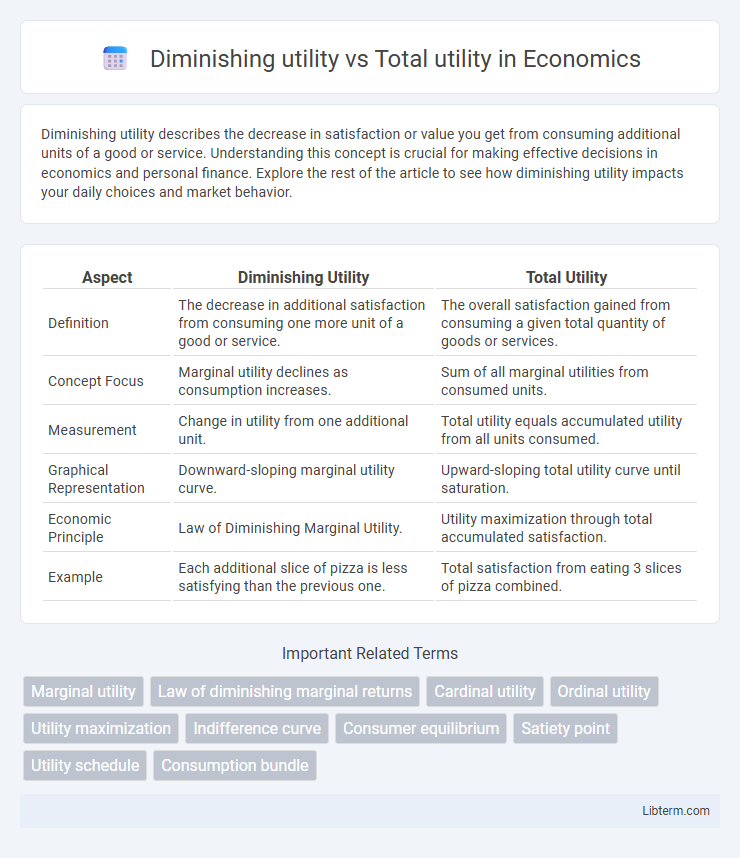Diminishing utility describes the decrease in satisfaction or value you get from consuming additional units of a good or service. Understanding this concept is crucial for making effective decisions in economics and personal finance. Explore the rest of the article to see how diminishing utility impacts your daily choices and market behavior.
Table of Comparison
| Aspect | Diminishing Utility | Total Utility |
|---|---|---|
| Definition | The decrease in additional satisfaction from consuming one more unit of a good or service. | The overall satisfaction gained from consuming a given total quantity of goods or services. |
| Concept Focus | Marginal utility declines as consumption increases. | Sum of all marginal utilities from consumed units. |
| Measurement | Change in utility from one additional unit. | Total utility equals accumulated utility from all units consumed. |
| Graphical Representation | Downward-sloping marginal utility curve. | Upward-sloping total utility curve until saturation. |
| Economic Principle | Law of Diminishing Marginal Utility. | Utility maximization through total accumulated satisfaction. |
| Example | Each additional slice of pizza is less satisfying than the previous one. | Total satisfaction from eating 3 slices of pizza combined. |
Understanding Utility: Basic Concepts
Diminishing utility refers to the decrease in additional satisfaction or utility gained from consuming each extra unit of a good or service, highlighting the principle that the first units consumed provide the highest utility. Total utility represents the cumulative satisfaction obtained from consuming all units of a good or service, increasing as consumption increases but at a decreasing rate due to diminishing utility. Understanding utility involves recognizing how consumers allocate resources to maximize total satisfaction while coping with the declining marginal benefit of additional consumption.
What is Total Utility?
Total utility refers to the overall satisfaction or benefit a consumer derives from consuming a certain quantity of goods or services. It represents the cumulative sum of utility gained from all units consumed, increasing as consumption grows but at a decreasing rate due to diminishing marginal utility. Understanding total utility helps in analyzing consumer behavior and optimizing consumption choices for maximum satisfaction.
What is Diminishing Marginal Utility?
Diminishing marginal utility refers to the decrease in the added satisfaction or benefit a consumer gains from consuming one more unit of a good or service, while total utility is the cumulative satisfaction received from all units consumed. As marginal utility diminishes, total utility continues to increase at a decreasing rate until it eventually plateaus. This concept explains consumer behavior by highlighting why demand curves typically slope downward.
The Relationship Between Total and Marginal Utility
Total utility represents the cumulative satisfaction gained from consuming a certain quantity of a good, while marginal utility measures the additional satisfaction from consuming one more unit. The relationship between these utilities reveals that total utility increases as long as marginal utility remains positive, but the rate of increase slows as marginal utility diminishes. When marginal utility reaches zero, total utility is maximized, indicating the point beyond which consuming additional units reduces overall satisfaction.
Graphical Representation of Utility
The graphical representation of diminishing utility illustrates a downward-sloping curve where marginal utility decreases as consumption increases, reflecting the principle that each additional unit of a good provides less added satisfaction. In contrast, the total utility curve rises at a decreasing rate and eventually plateaus, demonstrating cumulative satisfaction from all units consumed without declining. Together, these graphs visually depict how total utility maximizes while marginal utility diminishes, essential in consumer choice theory and utility analysis.
Law of Diminishing Marginal Utility Explained
The Law of Diminishing Marginal Utility states that as a consumer consumes more units of a good, the additional satisfaction (marginal utility) gained from each extra unit decreases. Total utility, the overall satisfaction from all units consumed, increases at a decreasing rate and eventually reaches a maximum point. Understanding this law is crucial for analyzing consumer choice behavior and optimizing resource allocation in economics.
Real-World Examples of Diminishing Utility
Diminishing utility occurs when the satisfaction gained from consuming each additional unit of a product decreases, such as when eating slices of pizza--while the first slice provides high satisfaction, the fifth slice offers significantly less enjoyment. Total utility, the cumulative satisfaction from all units consumed, increases at a decreasing rate due to this diminishing effect, eventually plateauing or even declining if consumption continues excessively. Real-world examples include consumer behavior in smartphone upgrades, where initial features add substantial utility, but subsequent versions contribute less perceived value over time.
Implications for Consumer Choice
Diminishing utility describes the decrease in additional satisfaction gained from consuming each extra unit of a good, directly impacting consumer choice by encouraging diversification in purchases to maximize overall satisfaction. Total utility represents the aggregate satisfaction derived from all units consumed, guiding consumers to allocate their budget where the total benefit outweighs the cost. Understanding the balance between diminishing marginal utility and total utility enables consumers to make informed decisions that optimize their overall happiness and resource utilization.
Utility in Economic Theory and Decision-Making
Utility in economic theory measures the satisfaction or benefit derived from consuming goods and services, playing a crucial role in decision-making processes. Diminishing utility refers to the decreasing additional satisfaction gained from consuming each extra unit of a good, which influences consumer choices and resource allocation. Total utility represents the overall satisfaction obtained from all units consumed, guiding individuals to optimize consumption for maximum benefit.
Comparing Diminishing Utility and Total Utility
Diminishing utility refers to the decrease in satisfaction or marginal utility a consumer experiences as they consume more units of a good or service, while total utility represents the overall satisfaction gained from consuming a certain quantity. Comparing diminishing utility and total utility highlights that total utility increases at a decreasing rate as additional units are consumed, eventually reaching a maximum point when marginal utility becomes zero. Understanding this relationship is crucial for analyzing consumer behavior and optimizing consumption choices.
Diminishing utility Infographic

 libterm.com
libterm.com